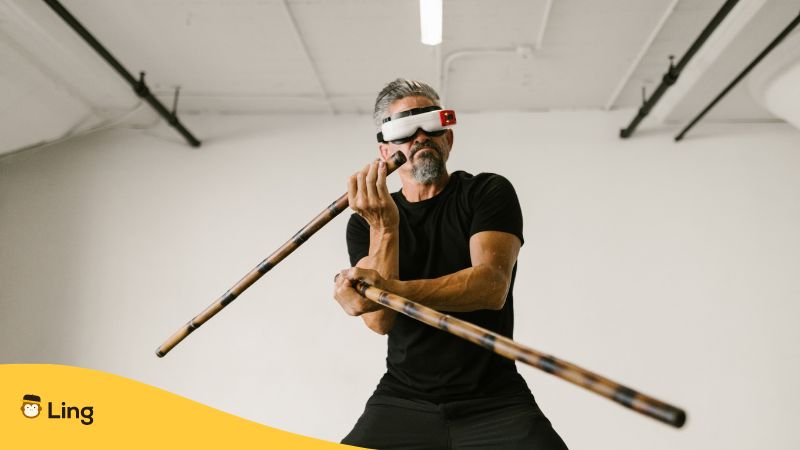So, you’re there, scrolling away, and suddenly, you’re like, “Hold up, Arnis-what now?”
I get it. You might be thinking, “Oh great, not another martial art with some fancy moves I’ll never get right.” But hang on, Arnis isn’t just any martial art about swinging sticks and looking cool. It’s a cultural practice that has its root in the Filipino history. Plus, you get to learn some cool Tagalog words that might impress your friends, or at least make for a good party trick.
What Is Arnis Martial Arts?
Arnis refers to the traditional martial arts of the Philippines. It originated as a system of fighting with weapons. Some of the key aspects are footwork and striking techniques using sticks rattan staffs batons blades or bare hands.
As a Filipino, I know that Arnis is considered an “art” that has ancient roots dating back to the 14th century. It evolved from indigenous methods of fighting developed to protect against animist warriors and pirates derivative influences came from the Spanish conquest of the islands. Characteristic techniques employ sticks representing swords knives and other blades. However, trained practitioners can also utilize common household objects or their bare hands.
When I first had my training for this, I noticed that it mainly focuses on fundamental angles and footwork patterns. And it’s a good thing! I mean, learning all those helped me establish strong foundations for advanced open-hand close-quarter grappling and disarming methods. The fighting style encourages an aggressive mobile offensive posture. Yet it also incorporates defensive principles of blocking parrying and control tactics.
But if you ask me, one thing you need to know about Arnis is that it exemplifies the blend of Spanish, Southeast Asian and Pacific influences on Filipino culture. Its diverse weaponry footwork and striking applications reflect the nation’s unique martial heritage. Proponents take pride in the art’s effectiveness as both a combat discipline and cultural tradition.

Why Learn Arnis As A Traveler/Expat?
First up, it’s all about self-defense on the fly. With Arnis, you can straight up use whatever is lying around as a weapon – sticks, blades, or just your bare hands. Perfect for those sketchy situations when you’re abroad, right?
But it’s not just about fighting. Arnis gets your body primed too. The footwork alone is a killer cardio workout. Then you’ve got the fast explosive drills that’ll have you sweating buckets. An active lifestyle is a must when traveling, so this Filipino sport of Arnis keeps you fit as hell.
The best part though? Full cultural immersion. Since it’s the national martial art of the Philippines, you get schooled in their rich history and values. The masters love sharing the deep philosophical side of it all. You’ll gain mad respect for the local traditions.
Moreover, you can’t forget the built-in social network too. Arnis has a worldwide community of tight-knit practitioners. Rock up to any school and you will instantly have a new crew to roll with. And trust me…They’ll hook you up with all the insider local tips to fully immerse.
Bottom line – Arnis is a traveler’s secret weapon. The practical self-defense, the insane conditioning, unlocking cultural understanding, having an instant group of friends wherever you go? What more could you want when exploring the world? Just immerse yourself in Arnis and every adventure becomes enhanced.
Where To Learn Arnis In The Philippines
So, where can you find your Arnis tribe in the Philippines? If you’re in the bustling metropolis of Manila, you’re in for a treat. The city is a hotbed of Arnis activity, with schools and clubs catering to every skill level. Check out places like the Doce Pares Multi-Style Eskrima Club, renowned for its comprehensive approach, or the UP Arnis Club, a breeding ground for champions.
If you’re island-hopping in the Visayas, make a beeline for Cebu. This island is the birthplace of Arnis, and the locals are fiercely proud of their martial arts heritage. Schools like Doce Pares Cebu are all about preserving the traditional teachings and passing them on to eager learners like you.

Tagalog Words Related To Filipino Martial Arts
As Arnis Martial Arts is deeply rooted in Filipino culture, it’s enriching for practitioners to familiarize themselves with relevant Tagalog terms. These words not only enhance your understanding of the art form but also show respect for its heritage and facilitate better communication within the local Arnis community.
| English | Tagalog |
|---|---|
| Martial Arts | Sining ng Pakikipaglaban |
| Stick | Baston |
| Knife | Kutsilyo |
| Sword | Espada |
| Fighting | Pakikipaglaban |
| Strike | Suntok |
| Kick | Sipa |
| Block | Harang |
| Technique | Teknik |
| Training | Pagsasanay |
| Warrior | Mandirigma |
| Defense | Depensa |
| Attack | Atake |
| Footwork | Paggalaw ng Paa |
| Hand-to-hand combat | Labanang Kamay sa Kamay |
| Instructor | Instruktor |
| Student | Estudyante |
| Practice | Praktis |
Learn Tagalog With Ling
As you go on your journey to learn Arnis Martial Arts in the Philippines, mastering the local language, Tagalog, can greatly enhance your experience and deepen your connection with the art form’s cultural roots. Fortunately, the Ling app provides a comprehensive and convenient solution for travelers and expats seeking to learn Tagalog effectively.
One of the key advantages of the Ling app is its user-friendly interface, which allows learners to navigate through the app’s extensive content with ease. The app offers a wide range of interactive lessons, covering essential vocabulary, grammar, and practical conversation skills, all of which are presented clearly and concisely.
Moreover, the Ling app employs a variety of proven language learning techniques, such as spaced repetition and gamification, to help users retain information more effectively and stay motivated throughout their learning journey. In addition to Tagalog, the Ling app offers courses in over 60 languages, with a particular focus on Eastern European and Asian languages. This makes it an invaluable resource for travelers and expats who wish to explore the rich linguistic diversity of the region.
Give Ling a try today by downloading it from the Play Store or the App Store!



































































